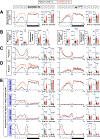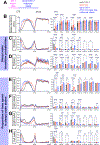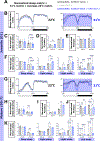Intrinsic maturation of sleep output neurons regulates sleep ontogeny in Drosophila
- PMID: 35985328
- PMCID: PMC9529826
- DOI: 10.1016/j.cub.2022.07.054
Intrinsic maturation of sleep output neurons regulates sleep ontogeny in Drosophila
Abstract
The maturation of sleep behavior across a lifespan (sleep ontogeny) is an evolutionarily conserved phenomenon. Mammalian studies have shown that in addition to increased sleep duration, early life sleep exhibits stark differences compared with mature sleep with regard to sleep states. How the intrinsic maturation of sleep output circuits contributes to sleep ontogeny is poorly understood. The fruit fly Drosophila melanogaster exhibits multifaceted changes to sleep from juvenile to mature adulthood. Here, we use a non-invasive probabilistic approach to investigate the changes in sleep architecture in juvenile and mature flies. Increased sleep in juvenile flies is driven primarily by a decreased probability of transitioning to wake and characterized by more time in deeper sleep states. Functional manipulations of sleep-promoting neurons in the dorsal fan-shaped body (dFB) suggest that these neurons differentially regulate sleep in juvenile and mature flies. Transcriptomic analysis of dFB neurons at different ages and a subsequent RNAi screen implicate the genes involved in dFB sleep circuit maturation. These results reveal that the dynamic transcriptional states of sleep output neurons contribute to the changes in sleep across the lifespan.
Keywords: Drosophila; central complex; development; dorsal fan-shaped body; ontogeny; ringer; sleep; sleep architecture.
Copyright © 2022 The Author(s). Published by Elsevier Inc. All rights reserved.
Conflict of interest statement
Declaration of interests The authors declare no competing interests.
Figures







Similar articles
-
Re-examining the role of the dorsal fan-shaped body in promoting sleep in Drosophila.Curr Biol. 2023 Sep 11;33(17):3660-3668.e4. doi: 10.1016/j.cub.2023.07.043. Epub 2023 Aug 7. Curr Biol. 2023. PMID: 37552985 Free PMC article.
-
The dorsal fan-shaped body is a neurochemically heterogeneous sleep-regulating center in Drosophila.PLoS Biol. 2025 Mar 26;23(3):e3003014. doi: 10.1371/journal.pbio.3003014. eCollection 2025 Mar. PLoS Biol. 2025. PMID: 40138668 Free PMC article.
-
Stem cell-specific ecdysone signaling regulates the development of dorsal fan-shaped body neurons and sleep homeostasis.Curr Biol. 2024 Nov 4;34(21):4951-4967.e5. doi: 10.1016/j.cub.2024.09.020. Epub 2024 Oct 8. Curr Biol. 2024. PMID: 39383867
-
Circadian Rhythms and Sleep in Drosophila melanogaster.Genetics. 2017 Apr;205(4):1373-1397. doi: 10.1534/genetics.115.185157. Genetics. 2017. PMID: 28360128 Free PMC article. Review.
-
Genes and neural circuits for sleep of the fruit fly.Neurosci Res. 2017 May;118:82-91. doi: 10.1016/j.neures.2017.04.010. Epub 2017 Apr 21. Neurosci Res. 2017. PMID: 28438481 Review.
Cited by
-
Modulation and neural correlates of postmating sleep plasticity in Drosophila females.Curr Biol. 2023 Jul 10;33(13):2702-2716.e3. doi: 10.1016/j.cub.2023.05.054. Epub 2023 Jun 22. Curr Biol. 2023. PMID: 37352854 Free PMC article.
-
Neurofibromin 1 regulates early developmental sleep in Drosophila.Neurobiol Sleep Circadian Rhythms. 2023 Aug 9;15:100101. doi: 10.1016/j.nbscr.2023.100101. eCollection 2023 Nov. Neurobiol Sleep Circadian Rhythms. 2023. PMID: 37593040 Free PMC article.
-
Local versus global sleep organization and the quest to determine sleep function.Neurobiol Sleep Circadian Rhythms. 2025 Apr 2;18(Suppl):100117. doi: 10.1016/j.nbscr.2025.100117. eCollection 2025 May. Neurobiol Sleep Circadian Rhythms. 2025. PMID: 40703581 Free PMC article.
-
Sleep timing in flies from "adolescence" to adulthood.Fly (Austin). 2025 Dec;19(1):2448022. doi: 10.1080/19336934.2024.2448022. Epub 2024 Dec 30. Fly (Austin). 2025. PMID: 39773381 Free PMC article.
-
Stem cell-specific ecdysone signaling regulates the development and function of a Drosophila sleep homeostat.bioRxiv [Preprint]. 2023 Oct 2:2023.09.29.560022. doi: 10.1101/2023.09.29.560022. bioRxiv. 2023. Update in: Curr Biol. 2024 Nov 4;34(21):4951-4967.e5. doi: 10.1016/j.cub.2024.09.020. PMID: 37873323 Free PMC article. Updated. Preprint.
References
-
- Roffwarg HP, Muzio JN, and Dement WC (1966). Ontogenetic Development of the Human Sleep-Dream Cycle. Science 152, 604–619. - PubMed
-
- Jouvet-Mounier D, Astic L, and Lacote D (1969). Ontogenesis of the states of sleep in rat, cat, and guinea pig during the first postnatal month. Developmental Psychobiology 2, 216–239. - PubMed
Publication types
MeSH terms
Substances
Grants and funding
LinkOut - more resources
Full Text Sources
Molecular Biology Databases

